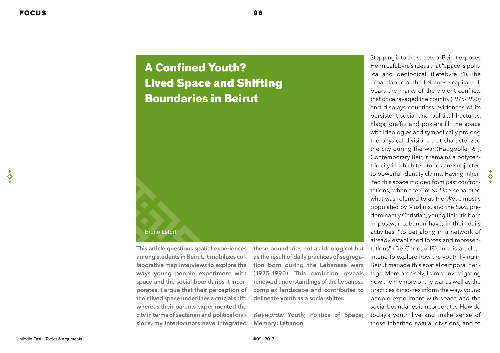A Confined Youth? Lived Space and Shifting Boundaries in Beirut
This article questions spatial experiences among students in Beirut. It mobilizes collaborative map interviews to explore the ways young people experiment with space and the social boundaries it incorporates. I argue that their perception of their lived space underlines a crucial shift: whereas thei...
I tiakina i:
| I whakaputaina i: | Middle East - Topics & Arguments |
|---|---|
| Kaituhi matua: | |
| Hōputu: | Artikel (Zeitschrift) |
| Reo: | Ingarihi |
| I whakaputaina: |
Philipps-Universität Marburg
2017
|
| Urunga tuihono: | Urunga tuihono |
| Tags: |
Tāpirihia he Tūtohu
Keine Tags, Fügen Sie den ersten Tag hinzu!
|
| Whakarāpopototanga: | This article questions spatial experiences among students in Beirut. It mobilizes collaborative map interviews to explore the ways young people experiment with space and the social boundaries it incorporates. I argue that their perception of their lived space underlines a crucial shift: whereas their parents experimented the city in terms of sectarian and political divisions, my interlocutors have integrated these boundaries not as ideological but as the result of daily practices of segregation born during the Lebanese wars (1975-1990). This evolution reveals renewed understandings of the Lebanese complex landscape and contributes to delineate youth as a social shifter. |
|---|---|
| DOI: | 10.17192/meta.2017.9.6836 |
 Publikationsserver
Publikationsserver